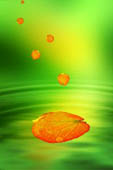
Purpose
NASA has long studied the effects of gravity on plants by taking plants with them during space expeditions and onto space stations. You can find out for yourself how plants grow in low gravity conditions by conducting this simple experiment.
Additional information
When plants are upright, they are growing directly against gravity. Since most plants grow in this manner, you can be sure that plants thrive by fighting against gravity. What would happen if plants were to be placed on their sides, where if they were to continue on their current path of growth, they would not be growing directly against gravity but rather, partly with it?
Sponsored Links
Required materials
- 3 bean plants or seeds
- 3 peat pellets (if using seeds only)
- 3 small to medium sized pots
- 1 medium bag potting soil
- 2 gallons distilled water
- Ruler
- Protractor
- Area in your home where the plants can reside for several weeks without being disturbed
- Journal or notebook paper
- Camera (if available)
Estimated Experiment Time
Several weeks.
Step-By-Step Procedure
- 1. Prepare bean plants by placing each plant or seed in one of your pots that have been filled with soil. If you are using a bean plant, you will need to plant it at about mid-depth within the pot. Seeds need to be sprouted in peat pellets before placing in pots if you are using seeds.
- 2. Once bean plants have been prepared, allow them to grow for a few weeks. Take photos if possible and record the plants’ growth in your journal or logbook.
- 3. Once the bean plants have reached about four or five inches high, turn the plants on their sides. This will create a “low gravity” condition.
- 4. Continue to allow the plants to grow, documenting their growth.
Note
You may want to consider mapping out your plants’ growth after the completion of the experiment by creating a growth chart. This will visually represent your findings.
Observation
Taking photographs if you can and documenting each measurement in your journal is a very important step in this project and must not be left out. These will truly illustrate your project to onlookers, helping them to understand the information you’re presenting.
Result
Scientists and technicians have found that plants will grow directly against gravity, no matter which way they are facing. Did your plants start to grow upwards again once they were placed sideways? Did placing them sideways cause them to change direction? What do you think happens to plants in low gravity conditions such as those on a space shuttle or space station?
Sponsored Links
Take a moment to visit our table of Periodic Elements page where you can get an in-depth view of all the elements,
complete with the industry first side-by-side element comparisons!